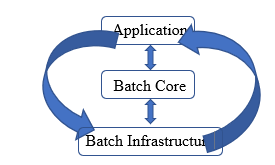Updated April 5, 2023

Definition of Spring Batch Architecture
Spring batch architecture is defined as a set of methods and/or rules that define how a computer system would function, organize, and/or get implemented in order to fulfill a certain task on processing batches on the Spring application framework. And in defining the architecture, the capabilities and the modelling is described in order to make users understand the usability of the same. In the current world, the enterprises require applications to contain the capability to process in bulk in order to complete the business operations with critical timelines, and this is where the processing in Spring Batch comes into play. This is a lightweight and comprehensive framework that allows applications to process batch processing for enterprises. The architecture is built on the Spring framework that includes POJO based approach for the development of applications, ease of use, improved productivity and hence extends the same benefits into the spring batch.
Explanation of Spring Batch Architecture
Getting into some history of the Spring Batch architecture. With the advent of API-based frameworks, there was increased popularity among enterprises building web and/or microservices-based frameworks. And due to the same, there is a notable shortfall in the development of processing requirements of Java-based applications. And as a result of that, many in-house solutions were developed. It was then time when SpringSource and Accenture collaborated together to formulate the Spring Batch architecture, which not only looked at the shortcomings as discussed earlier but also looked into a standardized processing approach in software, framework, and tool so that the enterprises can leverage the same for creation of an application that supports batch processing.
With this, we come to the usage scenario for the Spring Batch, and they are:
- For reading data from a database or file or a queue.
- Data processing as per the requirement so that the end result is in a format that is easily ingestible.
- The capability of the architecture is also to make sure that the application is capable of writing back the data as per the modified form after the processing.
Now let us understand the components of the Spring Batch first before we move on to the architecture level. The schematic diagram is as follows:
Let us now understand each of these components separately, as these components fall into the finite block of the Spring Batch architecture to finally complete the cycle.
Job Repository: This is like a storage house of elements that are sent to Job Launcher, Job and Step implementation to perform Create, Receive, Update, Delete (acronym’d as CRUD). The declaration of the job repository is done in the XML file. The XML also provides some extra options (which are optional except the id) so that the user can modify the parameters and create the repository as per the need of the application. For cases when an application doesn’t need the persisting of domain objects of the Spring Batch, the in0-memory version can be configured.
Job Launcher: With the given set of parameters for running a job by the Job repository, the job launcher is responsible for launching the Spring Job. This happens by the implementation of the JobLauncher interface. Job Launcher manages the condition of the next 2 elements in chronological order, i.e., Job and Step. It is also referenced in the XML as:
<bean id = "jobLauncher">
</bean>Job: This is the most important element of all and is the center focus of the entire Spring Batch architecture. A series of steps within a single execution unit which is sent for execution in an application. It is the batch process that is executed by the enterprises. In order to successfully execute the job, it needs to run from start to finish without any interruptions or errors. It is referenced in XML as:
<job id = " Job_ID">
…
</job>Within the tags, we define the respective steps along with the definition in order to successfully run the job. A very important component that is widely used is the restartable component, which is either false when one would want the application to not restart upon human intervention or true when an application needs to restart.
Step: This is the independent part within a job that contains respective commands to be executed and share the results. Within a job, there are “N” steps, and each step is connected in the XML to another step so as to define the entire chronology of the execution. An example of step is as follows:
<job id = "Job_ID">
<step id = "stepA" next = "stepB"/>
<step id = "stepB"/>
</job>Each job consists of multiple Item Reader, Item Processor, and Item Writer components in order to successfully complete the job.
- Item Reader: The task of an item reader is to read the data from a particular source and makes the data available to the item processor.
- Item Processor: The task of an item processor is to process the prepared data which comes from the item reader. This contains the processing code, which enables the processing of the data.
- Item Writer: After the item is read and processed, the modified version of the data needs to be written back into a particular destination, and this is what is enabled by Item Writer.
With these elements put together, the Spring Batch architecture is built and contains 3 components mainly.
The application consists of all the components related to the job and the code that is written in order to execute the code in Spring Batch Framework. The Batch Core contains the classes where API elements are stored so that they can be used when needed to control or launch a Batch job. Last but not least is the batch infrastructure that contains the components that are responsible for reading, writing, and processing using the code that is needed for processing.
Conclusion
In this article, we tried to understand the individual components and how they are stacked together to have the wonderful architecture of what we know today as the Spring Batch architecture that is used in so many scenarios in the genre of batch processing.
Recommended Articles
This is a guide to Spring Batch Architecture. Here we discuss the definition and detailed explanation of Spring Batch Architecture along with schematic diagram. You may also have a look at the following articles to learn more –


